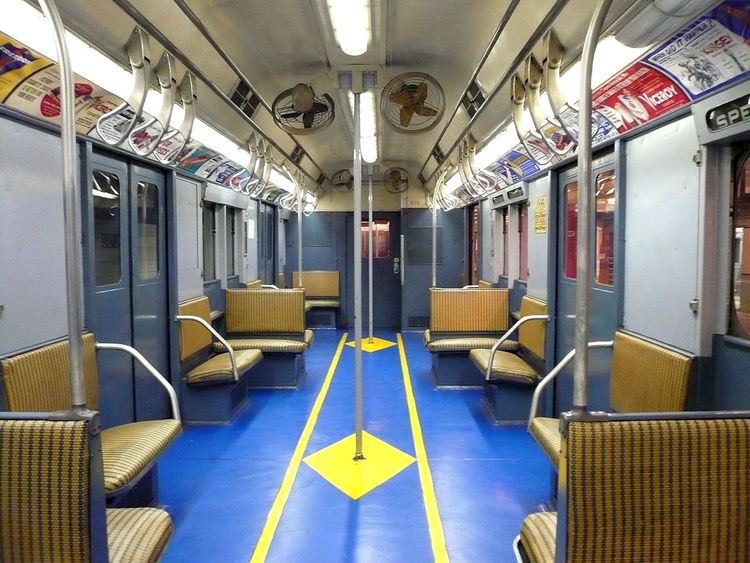Manufacturer American Car & Foundry Entered service 1948 Scrapped 1983–1984, 1988–1995 | Constructed 1948–1949 Refurbishment 1984–1986 Number built 400 | |
 | ||
The R10 was the first series of post-war New York City Subway cars. They were built by the American Car and Foundry Company in 1948 and 1949.
Contents
Description
The R10s were originally numbered 1803–1852 and 3000–3349. Cars 1803-1852 were renumbered 2950–2999 in 1970.
The R10 introduced many innovations. For the first time, the car body was of an all-welded low-alloy high tensile (LAHT) steel construction. This gave the body great strength, as the body and underframe were welded together to form a single, durable and rigid car body which had strong structural integrity. The R10s also featured a new type of braking system known as the "SMEE" schedule braking, which introduced dynamic braking. Dynamic braking reduced wear and tear on brake shoes, reducing maintenance costs. Improved propulsion, in the form of four 100 horsepower (75 kW) traction motors design instead of the traditional two 190 hp (140 kW) motors (the setup used in the Arnines) improved acceleration from 1.75 mph per second to the current 2.5 mph/s. They also featured roofline side destination signs, an arrangement that drew criticism. The R10s were also the first subway cars to incorporate roller bearings instead of the standard friction bearings found on all older railway stock, as well as being the last subway cars ordered with air-operated door engines. Finally, the cars introduced the General Steel Industries cast steel truck frame design also used on many passenger cars and coaches up until the R68As in 1989. Sealed beam headlights were installed on all cars of this class starting in 1956.
These cars were nicknamed Thunderbirds by their operating personnel and rail fans because of the cars' high speeds.
Although the R10s could operate in mixed consists of later SMEE cars, the R10s for the most part ran in solid consists throughout their careers, although they were briefly mixed with R16s in the late 1950s when fifty R16s cars were assigned to the A, and the R42s assigned to the A line during 1969-1970.
History
The R10s first ran in service on the A service on November 20, 1948. They were initially and exclusively assigned to the train, where they remained for almost 30 years and became synonymous with that route for more than 20 years.
Cars 3300-3349 were transferred to the BMT Eastern Division in 1954 to help familiarize crews with SMEE equipment in anticipation of the arrival of the R16 cars. Cars 3300-3319 were eventually transferred to the IND in 1956 to supply trains for the newly opened IND Rockaway Line, leaving cars 3320-3349 on the BMT Eastern Division's #15 Jamaica Line until 1961, when new R27s and R30s were delivered to the BMT Lines, which in turn transferred these cars back to the A.
The R10s were finally displaced from the A in 1969 when brand new R42 cars and displaced R40 cars were transferred from Jamaica Yard (which was in turn receiving brand new R46s) were directly assigned to the A (so that the A train could be equipped with some air-conditioned cars). The displaced R10s were then assigned to the B and rush hours-only CC (now the B and C) to replace aging R1s on that line. Some were also transferred to Jamaica Yard for use on the GG in order to fill a car shortage created by the R46 truck problems.
Car 3192 had a new R42 type front installed on that car in early 1975 to be the prototype car for an overhaul complete rebuilding of the fleet to be done with modern interiors and air-conditioning. The unit was scrapped in 1980 inside Coney Island Yard and the rebuilding program never took place.
While they may have been considered the second worst operating revenue service car during the 1980s based on MDBF (Mean Distance Between Failures), doing better than only the R46s, many R10s outlasted the newer R16s as well as a number of R27s and R30s. There was a light overhaul program for 110 cars between December 1984 and February 1986, in an effort to get the entire fleet in a non-graffiti state. The rehabilitation of the select R10s was done in-house at a budgeted cost of $65,000 per car.
Retirement
The R10s were finally replaced by the R68s and R68As. The last run of the GE R10s and the non-overhauled WH R10s was November 10, 1988, ten days short of the 40th anniversary of their debut. The rebuilt R10s would start being withdrawn by March 1989 until October 29, 1989, when a train of R10s (3018-3203-3182-2974-3143-3045-3145-3216) led final farewell excursion run on various IND-BMT Division routes, including the new IND 63rd Street Line. The R10s last operated in passenger service run was on the C on September 8, 1989.
The bulk of the scrapping of the remaining R10s ended in June 1990. The last R10 car to be removed from the New York City Transit Authority (TA) property was 3081, which was the only surviving GE-equipped unit in existence. It was scrapped sometime in 1993.
However, two cars have been preserved.
